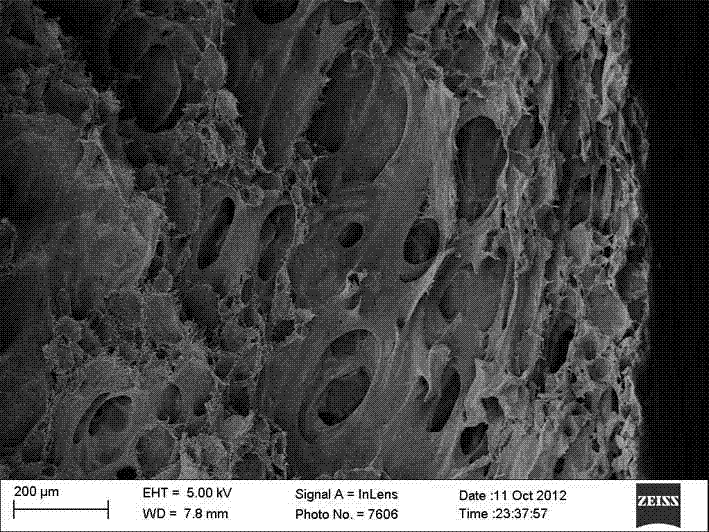Porous material for tissue engineering stent
A tissue engineering scaffold, porous technology, applied in the field of biomedical materials, can solve problems such as unfavorable cell migration and growth
- Summary
- Abstract
- Description
- Claims
- Application Information
AI Technical Summary
Problems solved by technology
Method used
Image
Examples
Embodiment 1
[0020] Polycaprolactone (granule), polyethylene oxide (powder), and sodium bicarbonate (powder) were prepared at a volume ratio of 1:1:1, and blended on a twin-screw extruder (BMP, US) and For granulation, the blending temperature was set at 100°C to prevent the premature decomposition of sodium bicarbonate. Then, injection foam molding was performed on a micro-foaming injection molding machine (Arburg Allrounder 320S equipped with Drexel Mucell gas supply system), and the molding temperature was set at 155°C (at this temperature, the thermal decomposition rate of sodium bicarbonate reached the maximum), and micropores were obtained. Foam injection molding products. Then put the injection molded product in a circulating water bath and leach for 72 hours to leach out sodium carbonate, the decomposition product of polyethylene oxide and sodium bicarbonate, and finally dry it in a vacuum oven for 48 hours to obtain an interconnected porous material . The porosity of the resulti...
Embodiment 2
[0022] Polycaprolactone (granular), polyethylene oxide (powder), and sodium bicarbonate (powder) were prepared according to the volume ratio of 3:2:3. Under the same steps and conditions as in Example 1, the internal The interconnected porous material has a porosity of 73.8%, a cell size of 20 microns to 250 microns, and an internal interconnected channel size of 20 microns to 200 microns.
Embodiment 3
[0024] Polycaprolactone (granular), polyethylene oxide (powder), and sodium bicarbonate (powder) were prepared according to a volume ratio of 2:3:2, and under the same steps and conditions as in Example 1, prepared The internal interconnected porous material has a porosity of 70.9%, a cell size of 20 microns to 250 microns, and an internal interconnected channel size of 20 microns to 200 microns.
PUM
| Property | Measurement | Unit |
|---|---|---|
| size | aaaaa | aaaaa |
| porosity | aaaaa | aaaaa |
| porosity | aaaaa | aaaaa |
Abstract
Description
Claims
Application Information
 Login to View More
Login to View More - R&D
- Intellectual Property
- Life Sciences
- Materials
- Tech Scout
- Unparalleled Data Quality
- Higher Quality Content
- 60% Fewer Hallucinations
Browse by: Latest US Patents, China's latest patents, Technical Efficacy Thesaurus, Application Domain, Technology Topic, Popular Technical Reports.
© 2025 PatSnap. All rights reserved.Legal|Privacy policy|Modern Slavery Act Transparency Statement|Sitemap|About US| Contact US: help@patsnap.com


